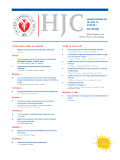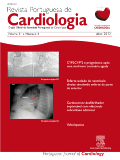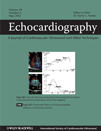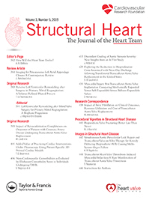
Journal of Echocardiography
Scope & Guideline
Connecting Knowledge with Cardiac Innovation
Introduction
Aims and Scopes
- Echocardiographic Techniques and Innovations:
The journal emphasizes advancements in echocardiographic techniques, including transthoracic, transesophageal, and three-dimensional echocardiography. It explores novel approaches to enhance imaging quality and diagnostic accuracy. - Clinical Applications in Cardiovascular Disease:
Papers often focus on the role of echocardiography in diagnosing and managing various cardiovascular conditions, such as heart failure, valvular heart disease, and congenital heart defects. - Integration of Technology and AI:
The journal covers the integration of artificial intelligence and automated systems in echocardiography, discussing their implications for reporting, diagnostics, and improving workflow efficiency. - Case Reports and Clinical Insights:
A significant portion of the journal consists of case reports that provide valuable insights into rare and complex cardiovascular conditions, showcasing the practical applications of echocardiography in diverse scenarios. - Research on Cardiac Mechanics:
There is a strong focus on studies related to myocardial mechanics, including strain and deformation analysis, which are critical for understanding cardiac function and dysfunction.
Trending and Emerging
- Artificial Intelligence in Echocardiography:
There is a marked increase in publications addressing the role of artificial intelligence and machine learning in echocardiographic reporting and analysis, reflecting a trend towards enhancing diagnostic accuracy and efficiency. - Advanced Strain Imaging Techniques:
Emerging research focuses on advanced strain imaging techniques, such as global longitudinal strain and speckle tracking, which are gaining importance for early detection of cardiac dysfunction, particularly in asymptomatic populations. - COVID-19 Related Cardiac Implications:
The journal has seen a surge in studies examining the cardiac effects of COVID-19, emphasizing the importance of echocardiography in managing complications associated with the virus. - Integration of Point-of-Care Ultrasound:
There is a growing interest in the use of point-of-care ultrasound in various clinical settings, highlighting its utility in rapid assessment and decision-making in acute care environments. - Focus on Heart Failure with Preserved Ejection Fraction (HFpEF):
Research related to the diagnosis and management of heart failure with preserved ejection fraction has gained traction, reflecting the complexity and increasing prevalence of this condition in clinical practice.
Declining or Waning
- Basic Echocardiographic Measurements:
Research focusing solely on traditional echocardiographic measurements without integrating advanced techniques has seen a decline, as the field moves towards more complex analyses that provide deeper insights into cardiac function. - Over-reliance on Single Modality Studies:
There is a noticeable reduction in studies that rely exclusively on echocardiography without a multi-modality approach. This trend aligns with the growing recognition of the need for comprehensive assessments using various imaging techniques. - Echocardiography in Non-Cardiac Conditions:
The exploration of echocardiography's applications in non-cardiac conditions has diminished, as the journal's focus has shifted more towards cardiovascular-specific research and advancements.
Similar Journals

HEART FAILURE REVIEWS
Exploring the Frontiers of Cardiology ResearchHEART FAILURE REVIEWS is a premier academic journal published by Springer, dedicated to the dynamic field of cardiology and cardiovascular medicine. With an impressive Q1 ranking in 2023, the journal stands as a vital resource for researchers, clinicians, and students seeking to stay abreast of the latest developments in heart failure management and research. Covering a broad spectrum of topics, including innovative therapies, epidemiology, and pathophysiology of heart failure, it fosters an environment for interdisciplinary collaboration. The journal is indexed with an ISSN of 1382-4147 and an E-ISSN of 1573-7322, ensuring widespread dissemination of knowledge. Although it does not currently offer open access options, its rigorous peer-review process guarantees high-quality content that contributes significantly to the scientific community. Established in 1996 and running through 2024, HEART FAILURE REVIEWS continues to be a leading platform for advancing understanding and treatment of heart conditions, making it an indispensable resource for all stakeholders in cardiac health.

INTERNATIONAL JOURNAL OF CARDIOVASCULAR IMAGING
Unveiling the Future of Cardiovascular DiagnosticsINTERNATIONAL JOURNAL OF CARDIOVASCULAR IMAGING, published by Springer, is a prestigious platform dedicated to the interdisciplinary field of cardiovascular medicine and imaging. With an ISSN of 1569-5794 and E-ISSN 1875-8312, the journal is recognized in both Cardiology and Cardiovascular Medicine (Rank #154/387, Q2 Category) and Radiology, Nuclear Medicine and Imaging (Rank #137/333, Q2 Category) disciplines, reflecting its significant impact within the scientific community. Established in 1988 and continuing to the present, it provides a rigorous forum for cutting-edge research, reviews, and clinical insights that are essential for advancing knowledge in cardiovascular diagnostics and therapeutic imaging. The journal's dual access options cater to both traditional and open-access readership, ensuring wide dissemination of its findings. In an era where cardiovascular diseases pose a significant public health challenge, the INTERNATIONAL JOURNAL OF CARDIOVASCULAR IMAGING stands out as an essential resource for researchers, healthcare professionals, and scholars aiming to innovate and improve patient outcomes through imaging technology.

Kardiologie
Bridging Research and Practice in Cardiology.Kardiologie is an emerging journal dedicated to advancing the field of cardiology and cardiovascular medicine, published by SPRINGER HEIDELBERG in Germany. Established with the first issue in 2022, this journal provides a valuable platform for the dissemination of innovative research, clinical studies, and review articles that contribute to both theoretical knowledge and practical applications in cardiology. While the journal currently holds a Q4 category ranking in the field and occupies a percentile of 24 according to Scopus, it aims to enhance its impact factor by attracting high-quality submissions from researchers and clinicians alike. Kardiologie is particularly focused on bridging the gap between cutting-edge research and clinical practice, ensuring that the latest scientific findings are readily accessible to practitioners. Though it operates under traditional access options at present, the journal aspires to broaden its accessibility and reach in future editions, making it a pertinent choice for anyone interested in the evolving landscape of cardiovascular health.

Nepalese Heart Journal
Illuminating the Path to Cardiovascular WellnessNepalese Heart Journal, published by the CARDIAC SOC NEPAL, serves as a premier platform for disseminating knowledge in the field of cardiology and cardiovascular health. With an ISSN of 2091-2978, this journal aims to bridge the gap between researchers, clinicians, and academicians by presenting high-quality, peer-reviewed articles that address clinical practices, innovative research, and emerging trends in heart disease management, especially within the context of Nepal and the surrounding region. Although it operates under a traditional publishing model, its commitment to excellence aids in reinforcing the scientific discourse in an area critical to public health. The journal is a valuable resource for professionals and students alike who are focused on advancing their understanding of cardiology and its implications for health policy and practice. Exploring the intersections of local challenges and global advancements in heart health, the Nepalese Heart Journal is poised to contribute meaningfully to the evolving landscape of cardiovascular research.

Hellenic Journal of Cardiology
Connecting Researchers and Clinicians for a Stronger Heart FutureThe Hellenic Journal of Cardiology, a peer-reviewed open-access publication under the esteemed ELSEVIER banner, proudly represents the forefront of research in the field of Cardiology and Cardiovascular Medicine. Established in 1993 and actively publishing since then, this journal has carved a niche in disseminating high-quality research and clinical insights relevant to cardiovascular health in Greece and beyond. With an impressive Q2 ranking in both Cardiology and Cardiovascular Medicine categories as of 2023, the journal holds a commendable position at Rank #126/387 in Scopus, indicative of its critical role in advancing scientific knowledge and practice. The Hellenic Journal of Cardiology transitioned to open access in 2016, ensuring that ground-breaking research is freely accessible, fostering a global dialogue among researchers, clinicians, and students alike. Its publication frequency spans significant years, providing a continuous flow of innovative findings while addressing pressing cardiovascular issues. As the journal builds on its legacy, it aspires to enrich the academic community's understanding of cardiovascular medicine, making it an invaluable resource for anyone invested in heart health.

Revista Portuguesa de Cardiologia
Exploring innovative solutions in cardiology since 1970.Revista Portuguesa de Cardiologia, published by Elsevier España SLU, stands as a pivotal resource in the realm of Cardiology and Cardiovascular Medicine. With its origins tracing back to 1970, this journal has cultivated a robust academic presence, achieving a 2023 Q3 ranking in its category, and currently holding a position of #220 out of 387 on the Scopus rankings, placing it within the 43rd percentile of its field. This open access journal, available since 2011, aims to disseminate high-quality research and insights relevant to contemporary cardiovascular issues. Its commitment to accessibility and knowledge exchange enhances its importance for clinicians, researchers, and students alike, fostering a more informed community in the fight against cardiovascular diseases. Operating from its base in Barcelona, Spain, the journal welcomes contributions that further the understanding and treatment of heart conditions, contributing significantly to the advancement of cardiovascular health.

ECHOCARDIOGRAPHY-A JOURNAL OF CARDIOVASCULAR ULTRASOUND AND ALLIED TECHNIQUES
Advancing the Art of Cardiovascular ImagingECHOCARDIOGRAPHY: A Journal of Cardiovascular Ultrasound and Allied Techniques is a premier scholarly publication committed to advancing the field of cardiovascular imaging through the dissemination of high-quality research and clinical studies. Published by Wiley, this journal has been a vital resource since its inception in 1984, aiming to bridge the gap between ultrasound techniques and clinical practice over its converged years extending to 2024. With an ISSN of 0742-2822 and an E-ISSN of 1540-8175, the journal is indexed in notable databases and holds a respectable standing in its field, reflected in its Q3 rankings in Cardiovascular Medicine, Miscellaneous Medicine, and Radiology for 2023. Though currently not open access, the journal strives to provide valuable insights and innovative techniques to researchers, professionals, and students alike, fostering a deeper understanding of echocardiography and its impact on patient care. Located in the United States, the journal continues to serve as a cornerstone for contemporary cardiovascular research and education, ensuring that the latest advancements and practices are readily accessible to the medical community.

Current Cardiovascular Imaging Reports
Advancing Innovations in Cardiovascular ImagingCurrent Cardiovascular Imaging Reports, published by SPRINGER, is a notable academic journal within the field of cardiovascular imaging. With its ISSN 1941-9066 and E-ISSN 1941-9074, this journal has been a critical resource since its inception in 2008, aiming to disseminate high-quality research and reviews in the realm of cardiovascular diagnostics and imaging technologies. Though currently categorized within the Q3 and Q4 quartiles for various fields such as Applied Microbiology and Biotechnology, Histology, and Cell Biology, its impact and relevance are growing steadily. Researchers and practitioners can benefit from the insights presented in this journal, especially as it covers advancements and practical applications in cardiovascular imaging techniques crucial for enhancing patient care. Given its ongoing commitment to open access, although not currently available, readers can engage with significant research findings that may inform future studies and applications in cardiology. With plans to converge towards 2024, this journal is poised to facilitate the exchange of knowledge and foster innovation within its dynamic field.

ACTA CARDIOLOGICA
Uniting professionals through groundbreaking cardiac studies.ACTA CARDIOLOGICA is a distinguished journal published by TAYLOR & FRANCIS LTD, focusing on the dynamic fields of Cardiology and Cardiovascular Medicine. Established in 1946, the journal has maintained a significant presence in the academic community, providing a platform for cutting-edge research and clinical studies that aim to address challenges in cardiovascular health. With its Q3 rating in both Cardiology and General Medicine categories, it showcases a robust compilation of articles that reflect the evolving landscape of cardiac care. Although ACTA CARDIOLOGICA is not an Open Access journal, it continues to serve a vital role for researchers, professionals, and students dedicated to advancing knowledge in cardiovascular health. This journal, with an ISSN of 0001-5385 and E-ISSN of 1784-973X, is a critical resource for those looking to stay updated on the latest developments and practices in the specialization, contributing significantly to the field until 2024 and beyond.

Structural Heart-The Journal of the Heart Team
Transforming patient care through shared expertise.Structural Heart - The Journal of the Heart Team, published by Elsevier Science Inc, is a leading journal dedicated to advancing the field of cardiology and cardiovascular medicine. Since its inception in 2017, this journal has committed to providing high-quality, peer-reviewed research and clinical insights aimed at enhancing patient care and interdisciplinary collaboration among heart teams. With an impressive Q2 ranking in the 2023 category of Cardiology and Cardiovascular Medicine, it positions itself in the upper tier of cardiovascular literature, supported by a robust Open Access model since 2022, enabling wider dissemination of knowledge. Covering a diverse range of topics including innovative treatment methodologies and latest outcomes in structural heart disease, this journal serves as an essential resource for researchers, clinicians, and students alike, fostering a deeper understanding of heart health and wellness.